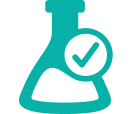Bioburden Testing
Bioburden testing measures the quantity of viable microorganisms—such as bacteria, yeasts and molds—on products, components or raw materials. For pharmaceutical and medical device manufacturers, it is a critical quality control step used to support sterilization validation, establish Sterility Assurance Levels (SAL) and monitor manufacturing environments for microbial control. By providing actionable data on both the quantity and, when paired with microbial identification, the type of organisms present, bioburden testing ensures compliance with regulatory requirements and mitigates patient risks associated with contamination, endotoxin release and product sterility failures.
Bioburden Testing Capabilities
By using validated culture-based methodologies and rapid testing options, Cambrex ensures accurate, reproducible results and timely product release. Our complete bioburden offering includes the following services:
Traditional Bioburden Testing
Our traditional bioburden testing methods quantify viable microorganisms on products, components and raw materials to establish the total microbial load. They vary depending on client’s specific needs, and may include the following:
- Membrane Filtration (MF) – Sample is passed through a sterile membrane to trap microorganisms, which are then incubated on nutrient media to grow colonies. Often used for liquids.
- Direct Plating/Pour Plate – Solid or semi-solid samples are plated directly onto agar and incubated for colony formation.
- Rinse/Wash Methods – Used for devices, components are rinsed with sterile fluid to remove microbes, and the rinse is cultured.
- Most Probable Number (MPN) – A statistical approach for estimating microbial counts in low-level or difficult-to-plate samples.
Rapid Bioburden Testing
Our rapid bioburden testing utilizes advanced technologies, such as Celsis® bioluminescence technology, to enable faster detection and microbial enumeration, supporting in-process monitoring and quicker decision-making. This accelerated approach not only maintains the highest standards of quality and regulatory assurance, but also helps you reduce inventory costs, streamline manufacturing, and bring products to market faster.
Heterotrophic Plate Count (HPC) Testing
Used for water testing and environmental monitoring samples, HPC quantifies the total number of heterotrophic bacteria present. Cambrex offers both mHPC and R2A methods, which are critical for monitoring water quality and environmental controls in pharmaceutical and medical device manufacturing facilities.
Accreditation & Regulatory Compliance
Our bioburden testing laboratories are FDA-registered, GMP-compliant and ISO 17025-accredited for medical devices, reflecting our commitment to excellence and regulatory compliance. Our methods are validated to USP <71>, EP 2.6.1, JP 4.06 and other international standards, as well as ANSI/AAMI/ISO 11737-1, ensuring your data is accepted by regulatory agencies worldwide.
Expertise and Client Support
Cambrex’s team of experienced analysts and microbiologists deliver high-quality bioburden testing services with quick and reliable turnaround times. Clients benefit from direct access to a dedicated account manager, who coordinates with our technical experts and operations teams to ensure proactive risk mitigation, project alignment with client goals, clear communication and prompt issue resolution.
We also offer courier services for sample pickup and delivery within a 150-mile radius of the Agawam, MA facility, ensuring sample integrity and convenience for clients.
Talk to one of our experts
Our scientists specialize in making connections. Start a conversation today and see how we can help with your bioburden testing.
Get in touch with an expert




